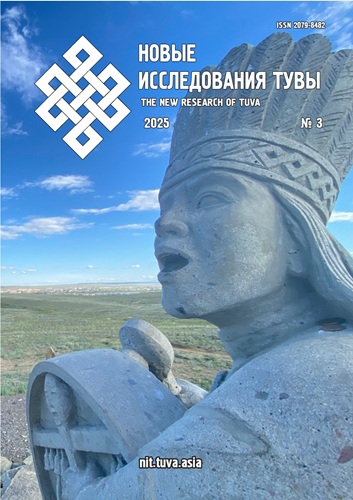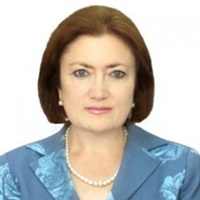Features of the representation of the conceptual dyad Zhashau — Elyum in the Karachay-Balkarian ethnic culture
DOI:
https://doi.org/10.25178/nit.2025.3.27Keywords:
ethnic culture; Karachay-Balkar culture; cultural concept; cognitive feature; life; death; conceptual dyadAbstract
The article examines the features of the concepts Zhashau — Elyum (‘life — death’) in Karachay-Balkar culture, which are understood as a conceptual dyad. The cultural concepts are analyzed within the framework of Ch. K. Lamazhaa’s theory in three aspects: concept-word-forms, concept-ideas, and concept-social regulators.
An analysis of the ideological content of the concepts revealed their complex structure, consisting of compound lexemes: jan ‘soul’, qadar ‘fate’, and zaman ‘time’, whose semantic content is determined by the historical and cultural experience of the Karachay-Balkar ethnic group.The etymological analysis of the concept-word-forms showed that the lexemes Zhashau and Elyum trace back to ancient Turkic roots, as evidenced by the presence of full equivalents or phonetic variants in other Turkic languages.
An analysis of the ideological content of the concepts revealed their complex structure, consisting of compound lexemes: jan ‘soul’, qadar ‘fate’, and zaman ‘time’, whose semantic content is determined by the historical and cultural experience of the Karachay-Balkar ethnic group. It includes a complex of axiological characteristics: prosperous, bright, trouble-free, honest, difficult, inglorious, disgraceful, short life predetermined from above, and inevitable death. One can also speak of cognitive features in which the profound aspects of life and death are explicated (temporality in this world, immortality of the soul, belief in fate, inevitability of life scenario, transience, irreversibility of time, etc.). In the consciousness of the Karachays and Balkars, Zhashau — Elyum are understood as logically interconnected beginning and end, predetermined by fate and time.
To understand the socio-regulatory aspect of the concepts, examples from the social practices of the Karachays and Balkars are provided. These examples document various ritual actions reflecting the ethnos’ attitude toward life and death, in particular, preparation for death as an inevitable fact, respect for the memory of the deceased, and memorial feasts.
References
Ахматова, M. A. (2014) The concept “soul” in the Karachay-Balkar language (based on the Nart epic). Izvestiya Kabardino-Balkarskogo nauchnogo tsentra RAN, no. 5(61), pp. 206–210. (In Russ.)
Bashieva, S. K., Gelyaeva, A. I. and Kuchukova, Z. A. (2011) Meanings and images of space and time in the system of ethnic identity. Filosofskie nauki, Special issue, no. 1, pp. 87–108. (In Russ.)
Bashieva, S. K., Dokhova, Z. R. and Chernyshova, E. B. (2024) Representation of value orientations of the Russian ethnos in phraseological units with the seme “life”. Nauchnaya mysl Kavkaza, no. 3, pp. 79–86. (In Russ.)
Guseinova, U. G. (2015) The concept “death” in the Old Turkic linguistic worldview. Vestnik Vyatskogo gumanitarnogo universiteta, no. 5, pp. 100–105. (In Russ.)
Dzhurtubaev, M. Ch. (2011) Mythology and epic of the Karachay-Balkar people: Ancient beliefs of Balkars and Karachays. Karachay-Balkar heroic epic. Nalchik, Elbrus. 488 p. (In Russ.)
Zelnitskaya, R. Sh. (2018) Modern funeral and memorial ritual among the Karachays. Izvestiya SOIGSI, no. 28(67), pp. 52–64. (In Russ.)
Kaspikhan, B. K. (2021) Cognitive world of the ancient Turks: knowledge about death in Turkic runic monuments. In: A. N. Varlamov (ed.). Languages and culture of the Khomus peoples of Eurasia: speech and musical communications: materials of the International scientific-practical conference dedicated to the 80th anniversary of Doctor of Philological Sciences, Professor of NEFU M. K. Ammosov, Academic of the European Academy of Natural Sciences, Honored Cultural Worker of Yakutia and Russia, Honorary Citizen of Yakutsk Ivan Egorovich Alexeev — Khomus Uybaan (Yakutsk, April 23, 2021). Yakutsk, Publishing House of NEFU. 513 p. Pp. 160–162. (In Russ.)
Lamazhaa, Ch. K. (2023) Cultural concepts: form, idea, social regulation. New Research of Tuva, no. 1, pp. 6–25. (In Russ.) DOI: https://doi.org/10.25178/nit.2023.1.1
Mongush, N. M. (2021) Euphemisms with the meaning “death” in Tuvan folk tales. In: N. V. Ekeev (ed.). Peoples of Altai in the sociocultural space of Russia at the turn of epochs: collection of articles dedicated to the 30th anniversary of the Republic of Altai and the 265th anniversary of the voluntary accession of the Altai people to the Russian state. Gorno-Altaisk, BNU RA “Research Institute of Altaistics named after S. S. Surazakov”. 924 p. Pp. 719–730. (In Russ.)
Tabaksoyeva, I. R. (2016) The concept “fate” as a nuclear component of the linguistic-cultural space (on the material of the Karachay-Balkar language). Nauchny dialog, no. 6 (54), pp. 106–113. (In Russ.)
Published
How to Cite
For citation:
Bashieva S. K. and Ulbasheva Z. M. Features of the representation of the conceptual dyad Zhashau — Elyum in the Karachay-Balkarian ethnic culture. New Research of Tuva, 2025, no. 3, pp. 448-458. DOI: https://doi.org/10.25178/nit.2025.3.27
Issue
Section

This work is licensed under a Creative Commons Attribution-NonCommercial 4.0 International License.

Author(s) license holder(s) grant rights for their work to the journal (grantee of a license) under the simple non-exclusive open license in accordance with Art. 1286.1 «Open license for a research work, work of literature or fine arts», Civil Code of the Russian Federation.
New Research of Tuva publishes articles under the Creative Commons Attribution-NonCommercial license (CC BY-NC).
Since it is an open license, author(s) reserve the right to upload the article to their institutional repository, submit it to another journal (if it allows republications), or republish it on their own website (in full, or in part).
However, several conditions apply here:
a) The republished version must always contain the name(s) and affiliation(s) of the author(s), the original title and the hyperlink to the original version on the New Research of Tuva website;
b) It must be in open access, free of charge, and no category of readers must be in any way whatsoever advantaged over general readership.
c) should the contribution be submitted elsewhere by its author(s) without substantial modification (30% or more of original text unchanged), the body of the article should contain a disclaimer that the original version was published in New Research of Tuva (with a link to the respective page)
The CC-BY-NC is a non-revocable license which applies worldwide and lasts for the duration of the work’s copyright.










